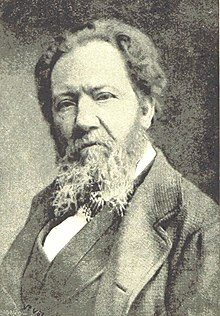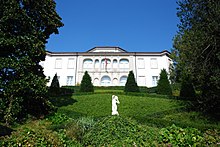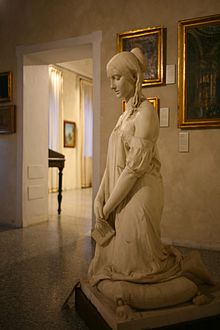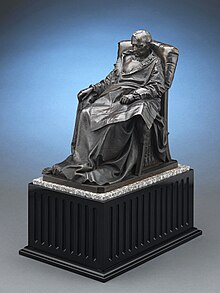Vincenzo Vela


Vincenzo Vela (born May 3, 1820 in Ligornetto , Canton Ticino , † October 3, 1891 ibid) was a Swiss sculptor of the 19th century and a major exponent of Verism .
Live and act
Childhood and education 1820–1844
Vincenzo Vela was born as the son of the farmer Giuseppe Vela and the landlady Teresa. Casanova was born as the youngest of six children. Like his two older brothers Giovanni and Lorenzo, he learned the stonemason craft at the age of nine in the quarries of Besazio . His brother Lorenzo Vela (1812-1897), who studied at the Accademia di Brera , recognized his talent and in 1834 brought him to Milan. Vela continued his apprenticeship as a stonemason there at the cathedral construction works and worked as a draftsman for a goldsmith.
At the same time, he studied from 1835 at the Accademia di Brera with Ferdinando Albertolli, Francesco Durelli, Luigi Sabbatelli, Pompeo Marchesi and Benedetto Cacciatori , in whose studio he also worked. Among his fellow students were Giuseppe Bertini , Giovanni Strazza and Pietro Magni . His artistic style changed to pronounced realism under the influence of the works of Francesco Hayez and Lorenzo Bartolini . At the academy he won several prizes; his relief " Raising the daughter of Jairus by Christ " was awarded a gold medal in 1842 by the Accademia di belle arti di Venezia . This success made him famous and gave him many orders, so that he went into business for himself after completing his studies in 1844.
Milan 1844-1852
His statue of Bishop Giuseppe Maria Luvini met with great approval and admiration, both in artistic circles and in circles of the aristocracy and the Milanese bourgeoisie. Commissions for various sculptures and tombs followed, which also brought pioneering formal innovations to cemetery art. For Duke Giulio Litta he created the genre sculpture The Morning Prayer (1846), whose innovative style was admired. With pronounced naturalism, great finesse in the portrait reproduction and the softness of the modeling, Vela combined proven composition patterns and old pictorial traditions with contemporary content.
Vela was a staunch Republican . After studying in Rome for several weeks, he voluntarily fought on the side of the federal troops under Guillaume-Henri Dufour (whom he also portrayed in 1849) in the Swiss Sonderbund War in 1847 . In 1848 he participated under Antonio Arcioni on the republican side in the first Italian war of independence of Lombardy against Austria and in the uprising in Como . He then returned to Milan.
On behalf of the Duke Antonio Litta, the larger than life marble sculpture of a slave was Spartacus , the bursts its chains - a work that for its artistic quality and as a patriotic symbol at the annual exhibition in Brera and the 1851 World Expo in London caused a sensation. Due to his style of representation, Vela became the main representative of the sculptors of realism and at the same time the carrier of the ideals of the Italian Risorgimento movement.
In 1852 Vela was appointed a member of the Accademia di Brera. After he returned the certificate of appointment - presumably for political reasons, since honorary memberships were also offered to high-ranking members of the Austrian aristocracy - this was interpreted as provocation by the authorities and Vela was consequently expelled from the Austrian kingdom of Lombardy-Veneto as an "undesirable foreigner" . He then went back to Ligornetto for a short time in July 1852.
1853-1867 Turin
Vela settled in Turin in February 1853 and in the same year married Sabina Dragoni, who he had already met in his youth in Benedetto Cacciatori's studio, where she was a model. In order to be able to cope with his numerous orders, he simultaneously operated three workshops with several employees. In Turin he was highly regarded, frequented the upper social circles and at the court of King Victor Emmanuel II. In 1856 he was appointed professor of sculpture at the Accademia Albertina .
Vela's numerous works from the 1850s include the statue of King Victor Emanuel II, the portrait of the young Countess Leopoldina d'Adda with a dog , the Bannerträger monument (in front of the Palazzo Madama ) and the Tell monument in Lugano as well as numerous monuments to well-known personalities such as Cesare Balbo (1856), Gabrio Piola (1857), Tommaso Grossi (1858) and Stefano Franscini (1860). There were also various grave sculptures such as The Mourning Harmony for the tomb of Gaetano Donizetti , the tomb for Antonio Rosmini and, among others, for the Turin families Calosso, Prever and Palestrini. He has also received commissions from Madrid, Lisbon, St. Petersburg, Constantinople and the USA, among others.
Vela exhibited regularly at the Salon de Paris . For his allegory Italy thanks France shown there in 1863 , he was made a Knight of the Legion of Honor in 1864. At the order of Empress Eugénie , he created the Columbus Monument (1867) for Colón . The sculpture The Last Moments of Napoleon I was shown in 1867 at the Paris World Exhibition in 1867 and by Napoleon III. acquired. Vela received a first class medal for this and was promoted to officer of the Legion of Honor .
1867-1891 Ligornetto
In 1867 he gave up teaching at the Accademia Albertina and returned to Ligornetto. He had previously had a villa built there, which served as a residence, studio and private museum, which he opened to the public in 1880. His plans to build an art school in Ticino - possibly even after his museum - failed due to a lack of support from the authorities.
Vela accepted commissions for portraits and grave monuments, sometimes also for scaled-down reproductions of his most famous works. He created Ecce Homo for the Cappella Giulini della Porta in Usmate Velate . A copy of it is on Vincenzo Vela's grave in Ligornetto.
In 1873 he was entrusted by the city of Geneva with the task of building the mausoleum for Duke Charles II of Braunschweig , who died in exile in Geneva. As there was no consensus on the artistic style, Vela terminated the contract.
As a politically active person, Vela was a member of the Grand Council of the Canton of Ticino from 1877 to 1881. From 1881 he was an advisory member of the cantonal commission for education and campaigned for the poor and public education. After the Ticino putsch in 1890, he traveled to Zurich to campaign for the accused's acquittal.
An example of Vela's social commitment is the monumental high relief Victim of Labor (1882), which he made of his own volition and without payment - as a tribute to the nameless miners who had an accident during the construction of the Gotthard railway tunnel . The work was presented at the first Swiss National Exhibition in Zurich in 1883 . Posthumous versions of the work in bronze are in Rome (Galleria d'Arte Moderna, Palazzo dell'Inail) and Airolo (train station, 1932).
His last public work was commissioned by the city of Como in 1888–89, the almost four-meter-high statue in honor of Giuseppe Garibaldi and the «Days of Como» in 1848 . For this he developed a colossal-scale modeling that was intended for implementation in bronze - a technique he had already used for the tomb of Maria Demartini Scala and the monument to Agostino Bertani .
Vela has received numerous honors and appreciations for his work. He took part in important international exhibitions such as several times in the Paris World Exhibitions as well as the World Exhibitions in London in 1862 and in Dublin in 1865 . In 1882 he was accepted as an external member of the Académie des Beaux-Arts .
Vincenzo Vela died on October 3, 1891 after a brief illness, his wife in 1892. His only son, the painter Spartaco Vela (1854–1895), bequeathed the Künstlerhaus-Museum with all the works it contained to the Swiss Confederation, according to his father's wishes on condition that it be kept open to the public as a museum or educational establishment.

Works (selection)
- 1839: The daughter of Jairus is raised from the dead by Christ
- 1845: Statue of Giuseppe Maria Bishop Luvini , Lugano Town Hall
- 1845: Maddalena Adami-Bozzi tomb , Pavia cemetery
- 1846: Cecilia Rusca's tomb , Locarno cemetery
- 1846: The morning prayer for Duke Giulio Litta
- 1850: Spartacus for Duke Antonio Litta
- 1852: Maria Isimbardi d'Adda on her deathbed , Chapel of the Adda, Villa Borromeo d'Adda, Arcore
- 1853: The Sorrowful , Chapel of the Adda, Villa Borromeo d'Adda, Arcore
- 1854: Portrait of the young Countess Leopoldina d'Adda with her dog
- 1854: Grave sculpture The Hope , Prever grave, Turin
- 1855: The resignation , grave Loschi-Dal Verme, Vicenza
- 1855: The mourning harmony , tomb for Gaetano Donizetti in the Church of Santa Maria Maggiore , Bergamo
- 1856: Tell monument in Lugano
- 1858: Tomb for Antonio Rosmini , Chiesa del Santissimo Crocifisso in Stresa
- 1859: Standard bearer , Palazzo Madama , Turin
- 1862: Italy thanks France ( L'Italia riconoscente alla Francia ), Compiègne Castle
- 1863: Statue of Camillo Benso Count von Cavour , Genoa (destroyed in 1942)
- 1865: Statue of Viktor Emanuell II , vestibule of the Palazzo Civico , Turin
- 1866: The last moments of Napoleon I . , Versailles
- 1867: Columbus Monument , Colón, Panama
- 1868: Ecce Homo , Cappella Giulini della Porta, Usmate Velate (copy on the tomb of Vincenzo Vela in Ligornetto)
- 1868: Tomb of Marie-Louise Joséphine Dufresne , Tour-en-Faucigny
- 1874: Tomb of Countess Maria Beatrice Giulini della Porta , Usmate-Velate
- 1882: Tomb of Maria Demartini Scala , Grancia
- 1882: The victims of labor / Vittime del lavoro , memorial for the victims of the Gotthard tunnel construction
- 1887: Monument by Agostino Bertani , Milan
- 1889: Statue of Giuseppe Garibaldi , Piazza della Vittoria, Como
- 1890: Tomb of Duke Ludovico Melzi d'Eril , Bellagio
Awards
- 1854: Appointed Cavaliere dell'Ordine dei Santi Maurizio e Lazzaro
- 1864: Appointed Chevalier de la Légion dʼhonneur
- 1867: Appointment as Officier de la Légion d'Honneur
Vela's grave in Ligornetto
The mausoleum , built in 1893 by Augusto Guidini , stands in the Ligornetto cemetery . It shows Vela on a mourning bed with a copy of his Ecce Homo created for the Cappella Giulini della Porta above it . In addition, a still life in bronze shows carbines, hammers, chisels and medals: the attributes of the celebrated republican and sculptor.
Museo Vela in Ligornetto
According to Vela's will, the Museo Vela (since 2014 Museo Vincenzo Vela ) was opened in his villa in 1898 . The original plaster models, drafts in clay, drawings, projects and photographs contained in the collection enable a detailed examination of the artistic, political and functional intentions of the sculptor and at the same time offer a multi-layered insight into the epoch in which the foundations for the free democracies of the West were placed. The museum also houses the estate of Lorenzo Vela and Spartaco Vela as well as u. a. Paintings by Lombard and Piedmontese artists of the 19th century.
Literature (selection)
- Eduard Platzhoff-Lejeune: Vincenzo Vela , in: Die Schweiz, Vol. 14, 1910, pp. 383 - 387
- Georg Kreis : Below and above. Vincenzo Vela's "Vittime del lavoro" from 1882/83, in: Bernard Degen et al. (Ed.): Window on History. 20 sources - 20 interpretations. Festschrift for Markus Mattmüller , Basel / Frankfurt a. M. 1992, pp. 163-182.
- Giorgio Zanchetti, Vincenzo Vela scultore 1820-1891 , dissertation, Critica, Teoria e Storia della letteratura e delle arti, IX ciclo, coordinator Giuseppe Farinelli, speaker Luciano Caramel, Università Cattolica del Sacro Cuore di Milano, Milan 1998.
- Gianna A. Mina Zeni (Ed.), Museo Vela. Le collezioni. Scultura, pittura, grafica, fotografia, Lugano 2002.
- Nancy J. Scott: Vincenzo Vela 1820-1891 . (Dissertation New York University, 1978), Garland Publishing, New York / London 1979.
- Marc-Joachim Wasmer: Il Museo Vela a Ligornetto. La casa-museo dello scultore ticinese Vincenzo Vela, Bern 2003.
- Gianna A. Mina: Vincenzo Vela. In: Historical Lexicon of Switzerland . January 5, 2015 , accessed January 18, 2020 .
- Marc-Joachim Wasmer: Museo Vincenzo Vela in Ligornetto , Bern: GSK Society for Swiss Art History, 2020.
Web links
- Literature by and about Vincenzo Vela in the WorldCat bibliographic database
- Museo Vela in Ligornetto (Switzerland)
- Vicenzo Vela in the Historical Lexicon of Switzerland
- Vela, Vinzenzo In: Sikart
- Vincenzo Vela in the archive database of the Swiss Federal Archives
- Vincenzo Vela on the website of the Canton of Ticino
- Vinzenzo Vela In: E-Periodica
Individual evidence
- ↑ a b c d e f g h Gianna A. Mina: Vela, Vincenzo. In: Dizzionarico Storico della Svizzera (DSS). Retrieved May 2, 2020 (Italian).
- ↑ a b c d e f g h i j k l m n o p q r Maria Cristina Brunati: Vincenzo Vela. Sculpture as an expression of freedom. In: Banca Popolare the Sondio Suisse. Retrieved May 5, 2020 .
- ↑ a b c d e f g h i j k l Eduard Platzhoff-Lejeune: Vincenzo Vela. In: ETH Zurich, e-periodica. Switzerland. Swiss illustrated magazine (Volume 14, 1910), pp. 383–387, accessed on May 2, 2020 .
- ↑ Museo Vincenzo Vela: Lorenzo Vela. Retrieved May 2, 2020 .
- ↑ a b c d e f g h i Museo Vincenzo Vela: Vincenzo Vela. Retrieved May 2, 2020 .
- ^ ETH Zurich: Tell-Dankmal in Lugano. In: e-periodica.ch. Retrieved May 2, 2020 .
- ↑ a b Adolf Seubert: The artists of all times and peoples: or life and works of the most famous builders, sculptors, painters, copper engravers, form cutters, lithographers etc. from the earliest art epochs to the present: based on the best sources Supplements since 1857: recent research on older artists, as well as an alphabetical overview of contemporary artists and their achievements . Ebner & Seubert, 1870 ( google.de [accessed on May 4, 2020]).
- ↑ Museo Vincenzo Vela: Spartaco Vela. Retrieved May 2, 2020 .
- ↑ Ecce Homo - Vincenzo Vela. Retrieved May 6, 2020 .
| personal data | |
|---|---|
| SURNAME | Vela, Vincenzo |
| BRIEF DESCRIPTION | Swiss sculptor |
| DATE OF BIRTH | May 3, 1820 |
| PLACE OF BIRTH | Ligornetto |
| DATE OF DEATH | October 3, 1891 |
| Place of death | Ligornetto |






